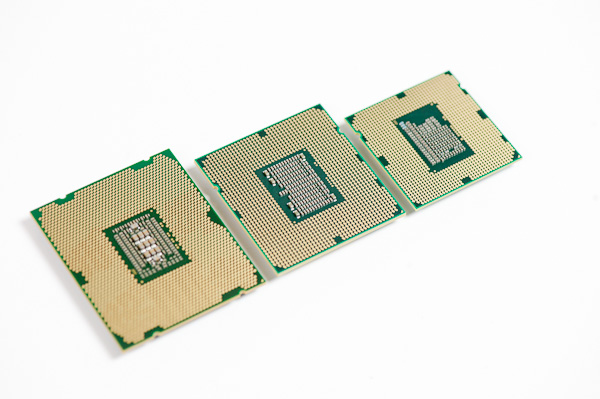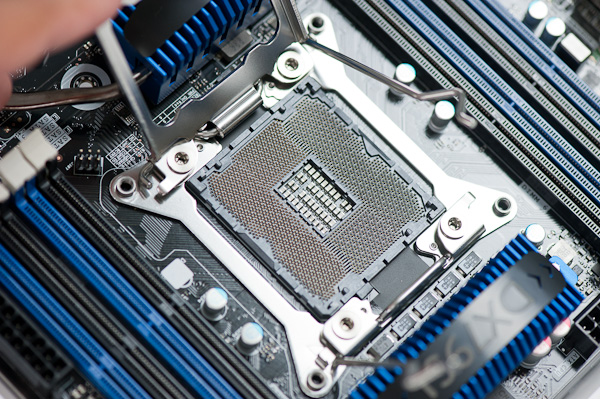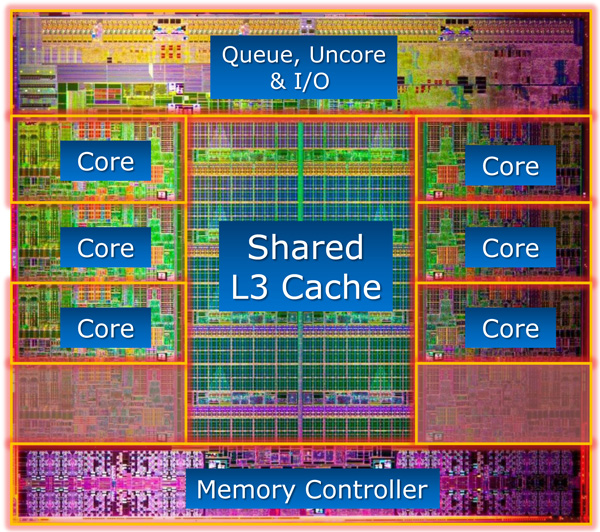Intel Core i7 3960X (Sandy Bridge E) Review: Keeping the High End Alive
by Anand Lal Shimpi on November 14, 2011 3:01 AM EST- Posted in
- CPUs
- Intel
- Core i7
- Sandy Bridge
- Sandy Bridge E
If you look carefully enough, you may notice that things are changing. It first became apparent shortly after the release of Nehalem. Intel bifurcated the performance desktop space by embracing a two-socket strategy, something we'd never seen from Intel and only once from AMD in the early Athlon 64 days (Socket-940 and Socket-754).
LGA-1366 came first, but by the time LGA-1156 arrived a year later it no longer made sense to recommend Intel's high-end Nehalem platform. Lynnfield was nearly as fast and the entire platform was more affordable.
When Sandy Bridge launched earlier this year, all we got was the mainstream desktop version. No one complained because it was fast enough, but we all knew an ultra high-end desktop part was in the works. A true successor to Nehalem's LGA-1366 platform for those who waited all this time.

Left to right: Sandy Bridge E, Gulftown, Sandy Bridge
After some delays, Sandy Bridge E is finally here. The platform is actually pretty simple to talk about. There's a new socket: LGA-2011, a new chipset Intel's X79 and of course the Sandy Bridge E CPU itself. We'll start at the CPU.
For the desktop, Sandy Bridge E is only available in 6-core configurations at launch. Early next year we'll see a quad-core version. I mention the desktop qualification because Sandy Bridge E is really a die harvested Sandy Bridge EP, Intel's next generation Xeon part:
If you look carefully at the die shot above, you'll notice that there are actually eight Sandy Bridge cores. The Xeon version will have all eight enabled, but the last two are fused off for SNB-E. The 32nm die is absolutely gigantic by desktop standards, measuring 20.8 mm x 20.9 mm (~435mm^2) Sandy Bridge E is bigger than most GPUs. It also has a ridiculous number of transistors: 2.27 billion.
Around a quarter of the die is dedicated just to the chip's massive L3 cache. Each cache slice has increased in size compared to Sandy Bridge. Instead of 2MB, Sandy Bridge E boasts 2.5MB cache slices. In its Xeon configuration that works out to 20MB of L3 cache, but for desktops it's only 15MB. That's just 1MB shy of how much system memory my old upgraded 386-SX/20 had.
| CPU Specification Comparison | ||||||||
| CPU | Manufacturing Process | Cores | Transistor Count | Die Size | ||||
| AMD Bulldozer 8C | 32nm | 8 | 1.2B* | 315mm2 | ||||
| AMD Thuban 6C | 45nm | 6 | 904M | 346mm2 | ||||
| AMD Deneb 4C | 45nm | 4 | 758M | 258mm2 | ||||
| Intel Gulftown 6C | 32nm | 6 | 1.17B | 240mm2 | ||||
| Intel Sandy Bridge E (6C) | 32nm | 6 | 2.27B | 435mm2 | ||||
| Intel Nehalem/Bloomfield 4C | 45nm | 4 | 731M | 263mm2 | ||||
| Intel Sandy Bridge 4C | 32nm | 4 | 995M | 216mm2 | ||||
| Intel Lynnfield 4C | 45nm | 4 | 774M | 296mm2 | ||||
| Intel Clarkdale 2C | 32nm | 2 | 384M | 81mm2 | ||||
| Intel Sandy Bridge 2C (GT1) | 32nm | 2 | 504M | 131mm2 | ||||
| Intel Sandy Bridge 2C (GT2) | 32nm | 2 | 624M | 149mm2 | ||||
Update: AMD originally told us Bulldozer was a 2B transistor chip. It has since told us that the 8C Bulldozer is actually 1.2B transistors. The die size is still accurate at 315mm2.
At the core level, Sandy Bridge E is no different than Sandy Bridge. It doesn't clock any higher, L1/L2 caches remain unchanged and per-core performance is identical to what Intel launched earlier this year.
The Lineup
| Processor | Core Clock | Cores / Threads | L3 Cache | Max Turbo | Max Overclock Multiplier | TDP | Price |
| Intel Core i7 3960X | 3.3GHz | 6 / 12 | 15MB | 3.9GHz | 57x | 130W | $990 |
| Intel Core i7 3930K | 3.2GHz | 6 / 12 | 12MB | 3.8GHz | 57x | 130W | $555 |
| Intel Core i7 3820 | 3.6GHz | 4 / 8 | 10MB | 3.9GHz | 43x | 130W | TBD |
| Intel Core i7 2700K | 3.5GHz | 4 / 8 | 8MB | 3.9GHz | 57x | 95W | $332 |
| Intel Core i7 2600K | 3.4GHz | 4 / 8 | 8MB | 3.8GHz | 57x | 95W | $317 |
| Intel Core i7 2600 | 3.4GHz | 4 / 8 | 8MB | 3.8GHz | 42x | 95W | $294 |
| Intel Core i5 2500K | 3.3GHz | 4 / 4 | 6MB | 3.7GHz | 57x | 95W | $216 |
| Intel Core i5 2500 | 3.3GHz | 4 / 4 | 6MB | 3.7GHz | 41x | 95W | $205 |
Those of you buying today only have two options: the Core i7-3960X and the Core i7-3930K. Both have six fully unlocked cores, but the 3960X gives you a 15MB L3 cache vs. 12MB with the 3930K. You pay handsomely for that extra 3MB of L3. The 3960X goes for $990 in 1K unit quantities, while the 3930K sells for $555.
The 3960X has the same 3.9GHz max turbo frequency as the Core i7 2700K, that's with 1 - 2 cores active. With 5 - 6 cores active the max turbo drops to a respectable 3.6GHz. Unlike the old days of many vs. few core CPUs, there are no tradeoffs for performance when you buy a SNB-E. Thanks to power gating and turbo, you get pretty much the fastest possible clock speeds regardless of workload.
Early next year we'll see a Core i7 3820, priced around $300, with only 4 cores and a 10MB L3. The 3820 will only be partially unlocked (max OC multiplier = 4 bins above max turbo).


















163 Comments
View All Comments
yankeeDDL - Monday, November 14, 2011 - link
I'm with you xpclient.I will never understand Microsoft's fanboys. Why do they expect the OS to make such huge impact on the benchmarks?
It's like for motherboards: you can differentiate for ease of use, stability, features, supported hardware ... but the benchmarks, will substantially be the same.
XP trails Windows7 on multi core because it was never designed to support so many cores, and MS has no interest in updating it.
Per Hansson - Monday, November 14, 2011 - link
Hi, what resolution and in game graphical settings where used for the World of Warcraft gaming test?It always amazes me how well that game scales with super high-end CPU's, but if it's at just a silly low resolution it does not really matter, so, which is it? (This isn't mentioned in "bench" either....)
Per Hansson - Monday, November 21, 2011 - link
Here is Anand's reply to this question incase anyone cares ;)---
1680 x 1050, 4X AA, all detail settings maxed (except for weather) :)
Take care,
Anand
Mightytonka - Monday, November 14, 2011 - link
Typo on the second page. Should read RST (Rapid Storage Technology), right?Ocire - Monday, November 14, 2011 - link
Nice review! :-)If you want to test PCIe bandwidth, you could use the bandwidth-test that comes with the CUDA SDK. It's easy to setup, and you can also test configurations with multiple GPUs. You should get quite reliable results for pure PCIe Gen.2 performance with that.
It would be really interesting to get some performance numbers for PCIe as that is the bottleneck in quite a few GPU-computing scenarios.
Cheers!
LancerVI - Monday, November 14, 2011 - link
Sounds like a great, enthusiast proc, married to a mainstream chipset at enthusiast prices.That means 'no joy' for me.
I guess I'll be hanging on to my little i7 920 that could for a bit longer. Going on 4 years now. That's unheard of for me!!!
hechacker1 - Monday, November 14, 2011 - link
I'm also going to hang onto the i7 920. Overclocked the x58 platform can still compete with the best of of Sandy Bridge for almost any workload. Sure we're missing some IPC and power enhancements, but nothing worth spending serious cash on.What I'm looking at now is the Gulftown prices. I'm hoping they come down from the $1000 Extreme part, and perhaps we get an affordable 6-core chip for the X58 platform.
I'd be happy to stick with Gulftown until we see affordable 8 core parts, or major IPC improvements.
Makaveli - Monday, November 14, 2011 - link
the 980 non X version is already going for $550This is your next upgrade, as is mine i'm also on a 920.
I doubt that price will drop any lower.
hechacker1 - Monday, November 14, 2011 - link
Yeah I'm going to be watching the prices closely for a while.At $550 for the lowest end Gulftown on newegg, it's still not affordable for me.
It's still cheaper than the intro prices of Sandy Bridge-E including a new motherboard though.
I'll have to watch forums closely for people wanting to sell their chips, I imagine you can snag one used for a good deal.
davideden - Monday, November 14, 2011 - link
I currently have a Core i7 2600K LGA 1155 processor. I am assuming that I won't be able to use this with the new LGA 2011 socket on the new Sandy Bridge E motherboards. Will there be any cheaper processors in the near future that are at the price point of the Core i7 2600K that are compatible? I was disappointed with not being able to utilize triple channel with my memory or being able to use all my sticks of ram with the current LGA 1155 motherboards. The quad channel ram along with the 8 slots have me most excited for the new platform as I do video editing/motion graphics/3D work. Thanks!